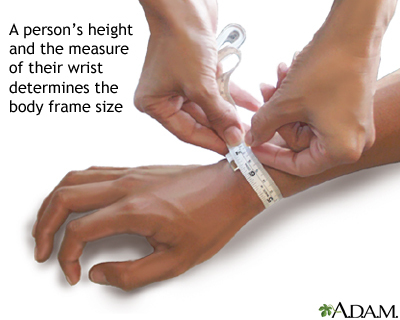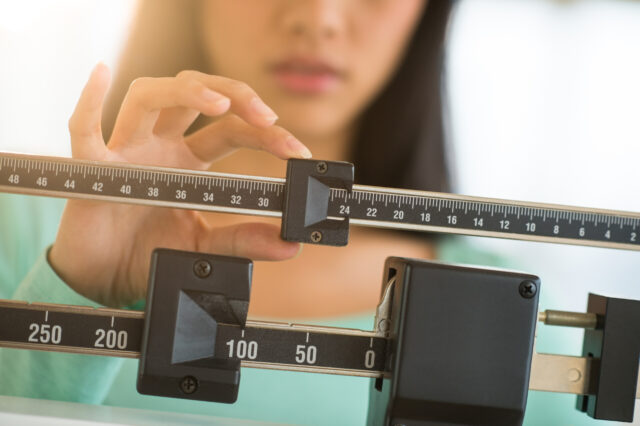Definition
A good way to decide if your weight is healthy for your height is to figure out your body mass index (BMI). You and your health care provider can use your BMI to estimate how much body fat you have.
Alternative Names
BMI; Obesity - body mass index; Obesity - BMI; Overweight - body mass index; Overweight - BMI
Information
Having obesity puts a strain on your heart and can lead to serious health problems. These include:
HOW TO DETERMINE YOUR BMI
Your BMI estimates how much you should weigh based on your height.
There are many websites with calculators that give your BMI when you enter your weight and height.
You can also calculate it yourself:
- Multiply your weight in pounds by 703.
- Divide that answer by your height in inches.
- Divide that answer by your height in inches again.
For example, a woman who weighs 270 pounds (122 kilograms) and is 68 inches (172 centimeters) tall has a BMI of 41.0.
Use the chart below to see what category your BMI falls into, and whether you need to be concerned about your weight.
Use the chart to see what category your BMI falls into| BMI | CATEGORY |
|---|
| Below 18.5 | Underweight |
|---|
| 18.5 to 24.9 | Healthy |
|---|
| 25.0 to 29.9 | Overweight |
|---|
| 30.0 to 39.9 | Obese |
|---|
| Over 40 | Extreme or high risk obesity |
|---|
There are three classes of obesity:
- Class 1: BMI of 30 to less than 35.
- Class 2: BMI of 35 to less than 40.
- Class 3: BMI of 40 or higher. Class 3 is considered "severe obesity."
BMI is not always the best way to decide whether you need to lose weight. If you have more or less muscle than is normal, your BMI may not be a perfect measure of how much body fat you have:
- Body builders. Because muscle weighs more than fat, people who are very muscular may have a high BMI.
- Older people. In older adults it is often better to have a BMI of 25 to 27, rather than under 25. If you are older than 65, for example, a slightly higher BMI may help protect you from thinning of the bones (osteoporosis).
- Children. While many children have obesity, DO NOT use this BMI calculator for evaluating a child. Talk to your child's provider about the right weight for your child's age.
Providers use a few methods to decide whether you are overweight. Your provider may also take your waist circumference and waist-to-hip ratio into consideration.
Your BMI alone can't predict your health risk, but most experts say that a BMI of 30 or greater (obesity) is unhealthy. No matter what your BMI is, exercise can help reduce your risk of developing heart disease and diabetes. Remember to always talk to your provider before starting an exercise program.
References
Centers for Disease Control and Prevention website. About adult BMI. www.cdc.gov/healthyweight/assessing/bmi/adult_bmi/index.html. Updated June 3, 2022. Accessed July 25, 2022.
Gahagan S. Overweight and obesity. In: Kliegman RM, St Geme JW, Blum NJ, Shah SS, Tasker RC, Wilson KM, eds. Nelson Textbook of Pediatrics. 21st ed. Philadelphia, PA: Elsevier; 2020:chap 60.
Jensen MD. Obesity. In: Goldman L, Schafer AI, eds. Goldman-Cecil Medicine. 26th ed. Philadelphia, PA: Elsevier; 2020:chap 207.


